Vishnu Statues
 QuickviewCompareFavoriteVishnu Balinese Brass Bust Hindu God on Black Wood Stand Statue 14.5"$249
QuickviewCompareFavoriteVishnu Balinese Brass Bust Hindu God on Black Wood Stand Statue 14.5"$249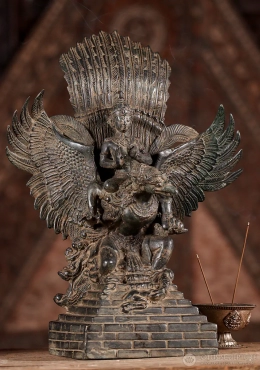 QuickviewCompareFavoriteVishnu Brass Statue Seated on Garuda with Elaborate Wings and Crown, Indonesia 14"$499
QuickviewCompareFavoriteVishnu Brass Statue Seated on Garuda with Elaborate Wings and Crown, Indonesia 14"$499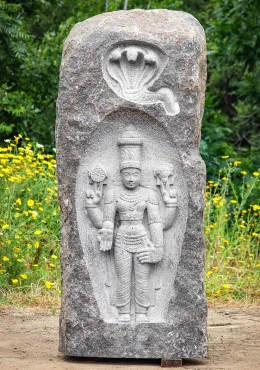 QuickviewCompareFavoriteLord Vishnu with Sesha & Andal with Parrot Double-Sided Granite Garden Sculpture 63"$7999
QuickviewCompareFavoriteLord Vishnu with Sesha & Andal with Parrot Double-Sided Granite Garden Sculpture 63"$7999 QuickviewCompareFavoriteVishnu Sculpture Cambodian Marble with 8 Arms Holding Weapons, Cobra & Symbolic Items 10.5"$799
QuickviewCompareFavoriteVishnu Sculpture Cambodian Marble with 8 Arms Holding Weapons, Cobra & Symbolic Items 10.5"$799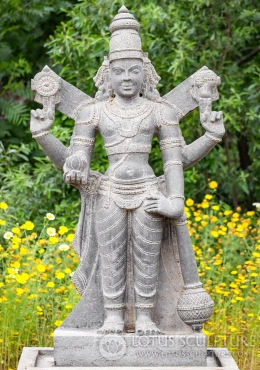 QuickviewCompareFavoriteVishnu Large Black Granite Garden Sculpture Holding Lotus and Mace Optional Base 51"$4499
QuickviewCompareFavoriteVishnu Large Black Granite Garden Sculpture Holding Lotus and Mace Optional Base 51"$4499 QuickviewCompareFavoriteShani Hindu God of Saturn Granite Garden Sculpture in Abhaya Mudra with Crow 28"$1299
QuickviewCompareFavoriteShani Hindu God of Saturn Granite Garden Sculpture in Abhaya Mudra with Crow 28"$1299 QuickviewCompareFavoriteVishnu's Feet Sculpture in Black Granite Paduka Symbol on Lotus Pedestal 8"$379
QuickviewCompareFavoriteVishnu's Feet Sculpture in Black Granite Paduka Symbol on Lotus Pedestal 8"$379 QuickviewCompareFavoriteDvarapala Sculpture with Club & Conch Black Granite Hindu Temple Guardian of the Divine 37"$1999
QuickviewCompareFavoriteDvarapala Sculpture with Club & Conch Black Granite Hindu Temple Guardian of the Divine 37"$1999 QuickviewCompareFavoriteHindu God Vishnu Sculpture Golden Bronze under Arch with Shreedevi & Bhudevi Hand Crafted 23"$4799
QuickviewCompareFavoriteHindu God Vishnu Sculpture Golden Bronze under Arch with Shreedevi & Bhudevi Hand Crafted 23"$4799 QuickviewCompareFavoriteNarasimha Brass Tranquil Yoga with Arms Resting on His Knees Chakra Discus & Conch 10.5"$299
QuickviewCompareFavoriteNarasimha Brass Tranquil Yoga with Arms Resting on His Knees Chakra Discus & Conch 10.5"$299 QuickviewCompareFavoriteBrass Garuda Sculpture with Arms and Wings Outstretched with 2 Nagas in Hands & Talons 34"$1699
QuickviewCompareFavoriteBrass Garuda Sculpture with Arms and Wings Outstretched with 2 Nagas in Hands & Talons 34"$1699 QuickviewCompareFavoriteBrass Garuda Statue with Arms and Wings Outstretched with 2 Nagas in Hands & Talons 34"$1699
QuickviewCompareFavoriteBrass Garuda Statue with Arms and Wings Outstretched with 2 Nagas in Hands & Talons 34"$1699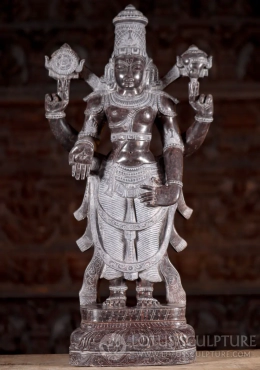 QuickviewCompareFavoriteVishnu Black Marble Standing Sculpture Varada Mudra Discus & Conch, India 25"$1399
QuickviewCompareFavoriteVishnu Black Marble Standing Sculpture Varada Mudra Discus & Conch, India 25"$1399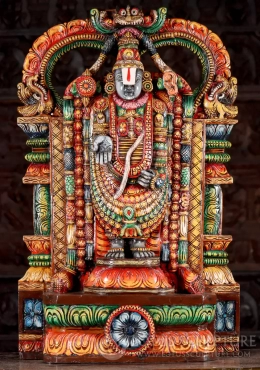 QuickviewCompareFavoriteBalaji Painted Wood Standing Statue Standing in Varada Mudra Carved in India 36"$849
QuickviewCompareFavoriteBalaji Painted Wood Standing Statue Standing in Varada Mudra Carved in India 36"$849 QuickviewCompareFavoriteBalaji Brass Lord Venkateswara Murti Presiding Deity of the Tirumala Venkateswara Temple 16"$299
QuickviewCompareFavoriteBalaji Brass Lord Venkateswara Murti Presiding Deity of the Tirumala Venkateswara Temple 16"$299 QuickviewCompareFavoriteBronze Standing Hariharan, Half Shiva, Half Vishnu Murti with Club, Ax, Staff, and Conch 24"$2369
QuickviewCompareFavoriteBronze Standing Hariharan, Half Shiva, Half Vishnu Murti with Club, Ax, Staff, and Conch 24"$2369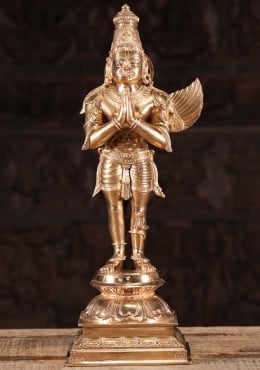 QuickviewCompareFavoriteHalf Garuda Half Hanuman Joined Together as 1 in Anjali Mudra Polished Bronze Statue of 18"$1799
QuickviewCompareFavoriteHalf Garuda Half Hanuman Joined Together as 1 in Anjali Mudra Polished Bronze Statue of 18"$1799 QuickviewCompareFavoriteBrass Vishnu Statue Holding Conch, Discus, Fly Whisk & Club with Namaste Garuda on Base 15"$249
QuickviewCompareFavoriteBrass Vishnu Statue Holding Conch, Discus, Fly Whisk & Club with Namaste Garuda on Base 15"$249 QuickviewCompareFavoriteBrass Hindu God Vishnu The Preserver & Lakshmi Laying On Ananta Sesha 10"$299
QuickviewCompareFavoriteBrass Hindu God Vishnu The Preserver & Lakshmi Laying On Ananta Sesha 10"$299 QuickviewCompareFavoriteNagakanya Wrapped in The Coils of A Five Headed Serpent Statue Holding Conch 13"$239
QuickviewCompareFavoriteNagakanya Wrapped in The Coils of A Five Headed Serpent Statue Holding Conch 13"$239 QuickviewCompareFavoriteBalinese Brass Flying Garuda Deepam Statue on Wooden Base Home Decor 12"$229
QuickviewCompareFavoriteBalinese Brass Flying Garuda Deepam Statue on Wooden Base Home Decor 12"$229 QuickviewCompareFavorite19th Century Antique Bronze Vishnu Vaikuntha Sculpture 4 Headed Vishnu in Tribhanga Posture 26"$8999
QuickviewCompareFavorite19th Century Antique Bronze Vishnu Vaikuntha Sculpture 4 Headed Vishnu in Tribhanga Posture 26"$8999 QuickviewCompareFavoriteVarahi StatueSouth Indian Panchaloha Bronze Seated with 4 Arms & Arch 7"$249
QuickviewCompareFavoriteVarahi StatueSouth Indian Panchaloha Bronze Seated with 4 Arms & Arch 7"$249 QuickviewCompareFavoriteVishnu Sandstone Sculpture with Buddhas, Eight-Arms in Standing Pose 92"$9999
QuickviewCompareFavoriteVishnu Sandstone Sculpture with Buddhas, Eight-Arms in Standing Pose 92"$9999 QuickviewCompareFavoriteStone Dattatreya Sculpture, Divine Union of Brahma, Vishnu & Shiva One of a Kind Masterpiece 51"$9999
QuickviewCompareFavoriteStone Dattatreya Sculpture, Divine Union of Brahma, Vishnu & Shiva One of a Kind Masterpiece 51"$9999 QuickviewCompareFavoriteVishnu Statue with 8 Arms, Large, Black Masterpiece Cambodian Stone Statue Wood Base 67.5"$14999
QuickviewCompareFavoriteVishnu Statue with 8 Arms, Large, Black Masterpiece Cambodian Stone Statue Wood Base 67.5"$14999 QuickviewCompareFavoriteNagakanya Statue with Wings, Snake Body, 5 Headed Serpent Holding a Conch Shell 14"$99
QuickviewCompareFavoriteNagakanya Statue with Wings, Snake Body, 5 Headed Serpent Holding a Conch Shell 14"$99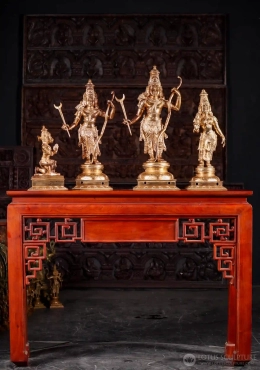 QuickviewCompareFavoriteRam Darbar Statue Set: Rama, Lakshmana, Sita, Hanuman with Detachable Weapons Bronze 28"$7499
QuickviewCompareFavoriteRam Darbar Statue Set: Rama, Lakshmana, Sita, Hanuman with Detachable Weapons Bronze 28"$7499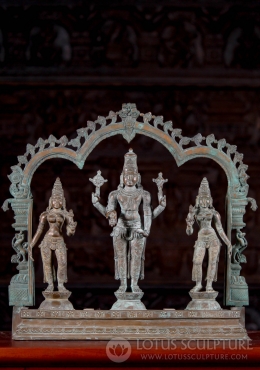 QuickviewCompareFavoriteVishnu with Consorts Bhudevi & Sridevi Antique Green Statue Cast South Indian Bronze 18"$3999
QuickviewCompareFavoriteVishnu with Consorts Bhudevi & Sridevi Antique Green Statue Cast South Indian Bronze 18"$3999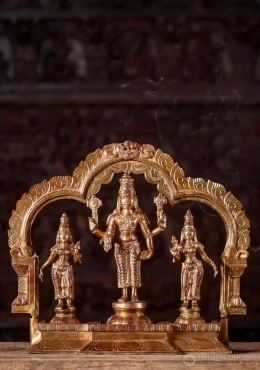 QuickviewCompareFavoriteVishnu with Bhudevi and Shreedevi Bronze Statue Set with Mahakala Arch 13"$699
QuickviewCompareFavoriteVishnu with Bhudevi and Shreedevi Bronze Statue Set with Mahakala Arch 13"$699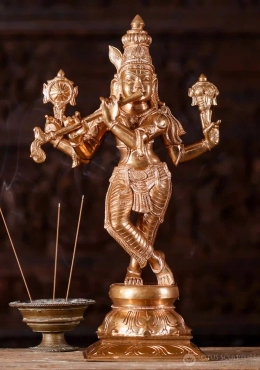 QuickviewCompareFavoriteVenugopal Statue the Synthesis of Krishna & Vishnu in 1 Form Polished Golden Bronze 17"$899
QuickviewCompareFavoriteVenugopal Statue the Synthesis of Krishna & Vishnu in 1 Form Polished Golden Bronze 17"$899 QuickviewCompareFavoriteLarge Venkateswara, Balaji Murti Presiding Deity of the Tirumala Venkateswara Temple 33"$1399
QuickviewCompareFavoriteLarge Venkateswara, Balaji Murti Presiding Deity of the Tirumala Venkateswara Temple 33"$1399 QuickviewCompareFavoriteVishnu Statue with Eight Arms - Hand-Carved Warm Tones in Unpolished Cambodian Marble 24"$2399
QuickviewCompareFavoriteVishnu Statue with Eight Arms - Hand-Carved Warm Tones in Unpolished Cambodian Marble 24"$2399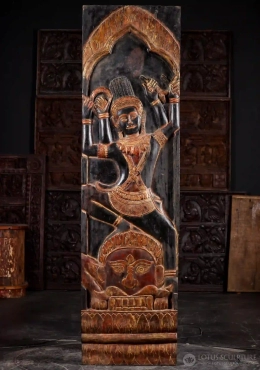 QuickviewCompareFavoriteDancing Vishnu Hindu Wood Panel with Four Arms on Asura Demon, Made in Cambodia 79"$2199
QuickviewCompareFavoriteDancing Vishnu Hindu Wood Panel with Four Arms on Asura Demon, Made in Cambodia 79"$2199 QuickviewCompareFavoriteVishnu Statue with Eight Arms - Intricate Details in Unpolished Cambodian Marble 16"$899
QuickviewCompareFavoriteVishnu Statue with Eight Arms - Intricate Details in Unpolished Cambodian Marble 16"$899 QuickviewCompareFavoriteLord Vishnu Statue Riding on the Shoulders of Garuda with Wings Outstretched 61"$10999
QuickviewCompareFavoriteLord Vishnu Statue Riding on the Shoulders of Garuda with Wings Outstretched 61"$10999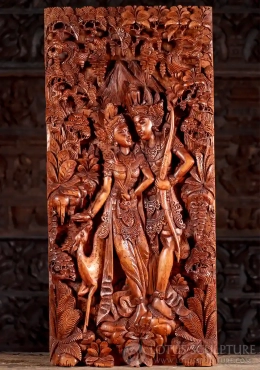 QuickviewCompareFavoriteRama and Sita Hand-Carved Wooden Panel with Bow and Deer in Jungle Canopy 39"$1999
QuickviewCompareFavoriteRama and Sita Hand-Carved Wooden Panel with Bow and Deer in Jungle Canopy 39"$1999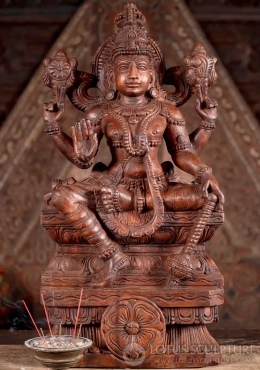 QuickviewCompareFavoriteVishnu Wooden Statue in Abhaya Mudra with Conch, Discus, and Club on Lotus Base 24"$339
QuickviewCompareFavoriteVishnu Wooden Statue in Abhaya Mudra with Conch, Discus, and Club on Lotus Base 24"$339 QuickviewCompareFavoriteWood Vishnu Statue with Ananta Sesha Standing on Lily Pad Ocean with Fish Hand Carving 32"$2499
QuickviewCompareFavoriteWood Vishnu Statue with Ananta Sesha Standing on Lily Pad Ocean with Fish Hand Carving 32"$2499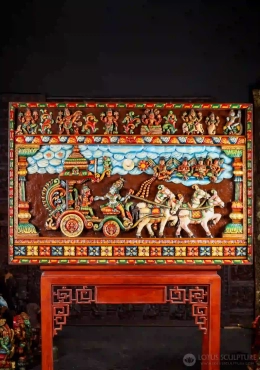 QuickviewCompareFavoriteBhagavad-Gita Wall Panel of Arjuna & Krishna on Horse-Drawn Chariot with Hanuman 72"$3599
QuickviewCompareFavoriteBhagavad-Gita Wall Panel of Arjuna & Krishna on Horse-Drawn Chariot with Hanuman 72"$3599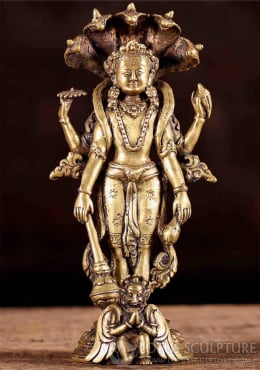 QuickviewCompareFavoriteVishnu Statue Standing Under Ananta Sesha with Garuda, Nepalese Brass Gold Finish 7.5"$159
QuickviewCompareFavoriteVishnu Statue Standing Under Ananta Sesha with Garuda, Nepalese Brass Gold Finish 7.5"$159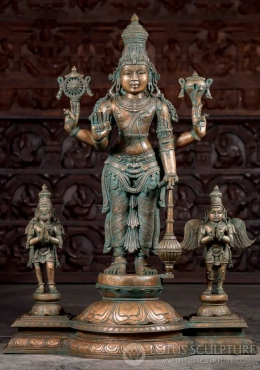 QuickviewCompareFavoriteVishnu Bronze Statue with Garuda and Hanuman in Panchaloha Antique Green Patina 45"$10999
QuickviewCompareFavoriteVishnu Bronze Statue with Garuda and Hanuman in Panchaloha Antique Green Patina 45"$10999 QuickviewCompareFavoriteBronze Unique Murti of Seated Vishnu with Bhudevi & Sridevi Hand Made in Bangladesh 16"$999
QuickviewCompareFavoriteBronze Unique Murti of Seated Vishnu with Bhudevi & Sridevi Hand Made in Bangladesh 16"$999- 1
- 2
Hindu God Vishnu Statues
Vishnu is one of the principal Hindu Gods, worshipped as the preserver of the world and defender and restorer of dharma (moral order). All Vishnu statues are handcrafted in Indian villages. Vishnu is familiar chiefly through his avatars (incarnations), particularly Rama, Krishna and Buddha. As per theory, Vishnu incarnates a portion of himself whenever he is needed to fight evil, and his incarnations are innumerable; but practically, ten incarnations of Vishnu are most commonly recognized.
Lord Vishnu Sculptures & His Incarnations
Lord Vishnu, or the Preserver of the Hindu triad, is a symbol of protection, sympathy, and restoration of cosmic balance. He is generally depicted with four arms holding the conch (shankha), discus (chakra), mace (gada), and lotus (padma), which symbolize the different aspects of his divine personality. Vishnu's incarnations, including Rama, Krishna, and Narasimha, are worshipped for their deeds of reinstating dharma and guiding mankind.
Vishnu Statues Materials
Our Vishnu statues are handcrafted by skilled artisans in India, using traditional techniques passed down through generations. Available in materials such as black marble, wood, brass, bronze, and stone, each Vishnu statue reflects intricate details and vibrant expressions characteristic of Vishnu's depictions. Whether it's Vishnu standing majestically, reclining on the serpent Ananta, or accompanied by his consort Lakshmi, our collection captures these iconic forms with precision and devotion.
God Vishnu's Energy in Your Space
Vishnu Statues are for more than home decor, they are a way to create a welcoming spirit of protection, inner peace, and divine order into your living experience. Whether you set the statue in your meditation room, living area, or altar-feasting table, Lord Vishnu brings strength and tranquillity to the space. Combine your Vishnu statue with other Hindu God Statues such as Lakshmi, Shiva, or Hanuman to complete your space.
Why Choose Lotus Sculpture?
At Lotus Sculpture, we travel across the globe to bring you authentic spiritual art. We work directly with artisans who carry forward traditional carving techniques.
Every piece we offer is personally chosen for its quality, detail, and energy. Our major goal is to help you connect with the divine through statues that are meaningful and filled with devotion.
Frequently Asked Questions (FAQs)
1. Who is Lord Vishnu in Hinduism?
Lord Vishnu is one of the principal deities in Hinduism. He is the preserver and protector of the universe and is also known for maintaining balance and peace.
2. What do the discus and conch in Vishnu's hands represent?
The discus (chakra) symbolises the destruction of evil. On the other hand, the conch (shankha) represents the spread of divine sound and wisdom.
3. Can I place a Vishnu statue in my home altar?
Yes. A Vishnu Statue is perfect for a home altar, meditation space, or sacred corner. It brings peace and divine energy into your home.
4. What is the difference between Vishnu and Balaji statues?
Balaji, also known as Venkateswara, is a popular avatar of Lord Vishnu. Balaji statues are usually worshipped in South India, especially at the famous Tirupati temple.
5. Are your Vishnu statues handmade?
Yes. All our statues, including marble, brass, and wood Vishnu Statues, are handcrafted by skilled artisans in India using traditional methods.
6. What size Vishnu statue should I choose?
Smaller sizes are great for altars or desks, while larger statues like our 71" Balaji sculpture are ideal for temples, spacious rooms, or garden shrines.
7. Do you ship worldwide?
Yes, Lotus Sculpture offers worldwide shipping, with special offers on many of our Hindu God Statues.

